University Management: Strategic Planning and Organizational Behavior
VerifiedAdded on 2023/01/11
|6
|907
|50
Report
AI Summary
This report examines the dangers of a flawed mission statement, detailing how it can hinder organizational actions and objectives by failing to provide clear guidance, direction, or purpose to employees. It explores the negative impacts on the development of a unit's mission statement, individual job descriptions, and overall goals, emphasizing how a flawed mission can lead to a shift away from the company's intended objectives. The report further describes the unique features of organizational development, distinguishing it from other change initiatives by highlighting its focus on planned change, its encompassing nature, its long-term orientation, and its emphasis on systems and problem-solving. It also notes the use of independent change agents, collaborative management, and reliance on group processes, providing a comprehensive analysis of the subject matter.
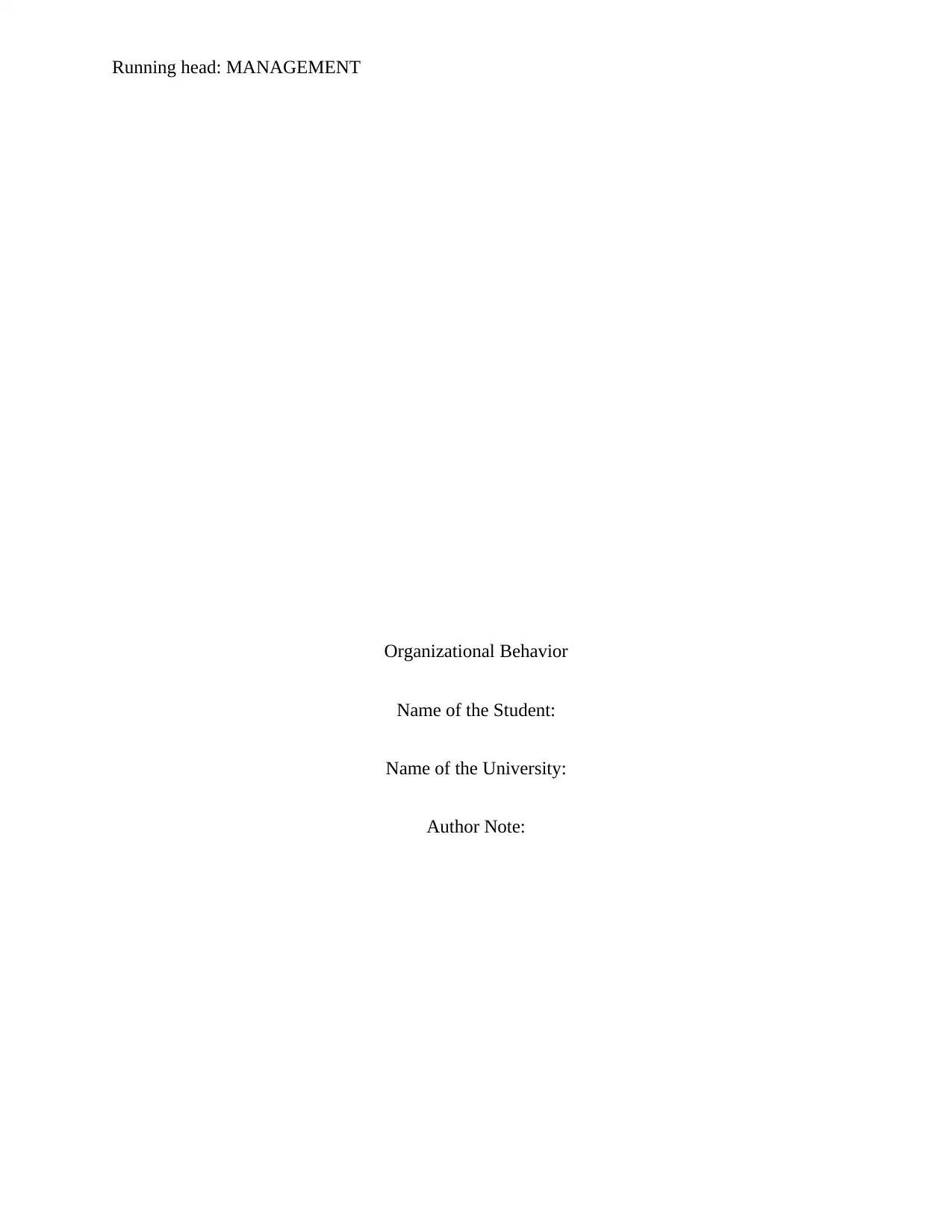
Running head: MANAGEMENT
Organizational Behavior
Name of the Student:
Name of the University:
Author Note:
Organizational Behavior
Name of the Student:
Name of the University:
Author Note:
Paraphrase This Document
Need a fresh take? Get an instant paraphrase of this document with our AI Paraphraser
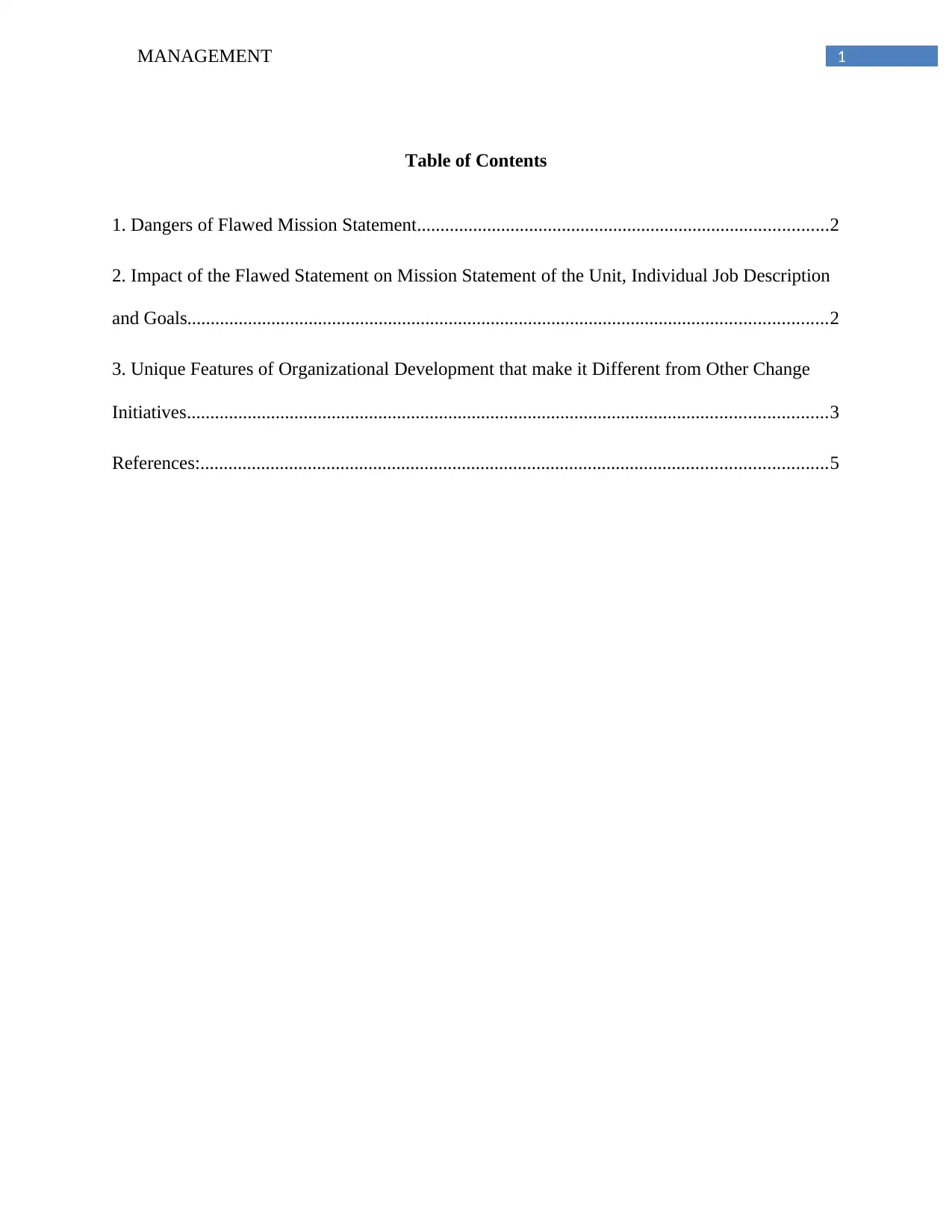
1MANAGEMENT
Table of Contents
1. Dangers of Flawed Mission Statement........................................................................................2
2. Impact of the Flawed Statement on Mission Statement of the Unit, Individual Job Description
and Goals.........................................................................................................................................2
3. Unique Features of Organizational Development that make it Different from Other Change
Initiatives.........................................................................................................................................3
References:......................................................................................................................................5
Table of Contents
1. Dangers of Flawed Mission Statement........................................................................................2
2. Impact of the Flawed Statement on Mission Statement of the Unit, Individual Job Description
and Goals.........................................................................................................................................2
3. Unique Features of Organizational Development that make it Different from Other Change
Initiatives.........................................................................................................................................3
References:......................................................................................................................................5
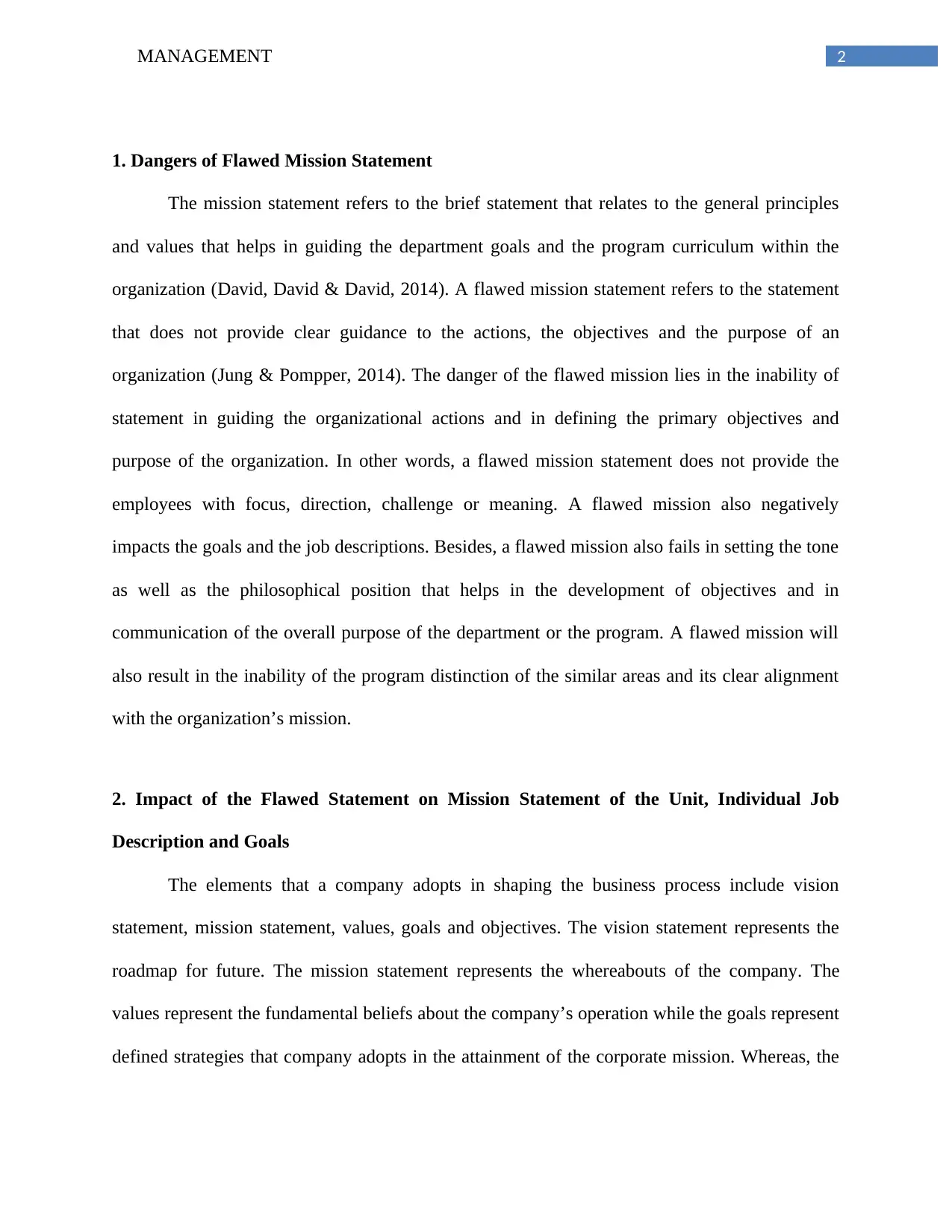
2MANAGEMENT
1. Dangers of Flawed Mission Statement
The mission statement refers to the brief statement that relates to the general principles
and values that helps in guiding the department goals and the program curriculum within the
organization (David, David & David, 2014). A flawed mission statement refers to the statement
that does not provide clear guidance to the actions, the objectives and the purpose of an
organization (Jung & Pompper, 2014). The danger of the flawed mission lies in the inability of
statement in guiding the organizational actions and in defining the primary objectives and
purpose of the organization. In other words, a flawed mission statement does not provide the
employees with focus, direction, challenge or meaning. A flawed mission also negatively
impacts the goals and the job descriptions. Besides, a flawed mission also fails in setting the tone
as well as the philosophical position that helps in the development of objectives and in
communication of the overall purpose of the department or the program. A flawed mission will
also result in the inability of the program distinction of the similar areas and its clear alignment
with the organization’s mission.
2. Impact of the Flawed Statement on Mission Statement of the Unit, Individual Job
Description and Goals
The elements that a company adopts in shaping the business process include vision
statement, mission statement, values, goals and objectives. The vision statement represents the
roadmap for future. The mission statement represents the whereabouts of the company. The
values represent the fundamental beliefs about the company’s operation while the goals represent
defined strategies that company adopts in the attainment of the corporate mission. Whereas, the
1. Dangers of Flawed Mission Statement
The mission statement refers to the brief statement that relates to the general principles
and values that helps in guiding the department goals and the program curriculum within the
organization (David, David & David, 2014). A flawed mission statement refers to the statement
that does not provide clear guidance to the actions, the objectives and the purpose of an
organization (Jung & Pompper, 2014). The danger of the flawed mission lies in the inability of
statement in guiding the organizational actions and in defining the primary objectives and
purpose of the organization. In other words, a flawed mission statement does not provide the
employees with focus, direction, challenge or meaning. A flawed mission also negatively
impacts the goals and the job descriptions. Besides, a flawed mission also fails in setting the tone
as well as the philosophical position that helps in the development of objectives and in
communication of the overall purpose of the department or the program. A flawed mission will
also result in the inability of the program distinction of the similar areas and its clear alignment
with the organization’s mission.
2. Impact of the Flawed Statement on Mission Statement of the Unit, Individual Job
Description and Goals
The elements that a company adopts in shaping the business process include vision
statement, mission statement, values, goals and objectives. The vision statement represents the
roadmap for future. The mission statement represents the whereabouts of the company. The
values represent the fundamental beliefs about the company’s operation while the goals represent
defined strategies that company adopts in the attainment of the corporate mission. Whereas, the
⊘ This is a preview!⊘
Do you want full access?
Subscribe today to unlock all pages.

Trusted by 1+ million students worldwide
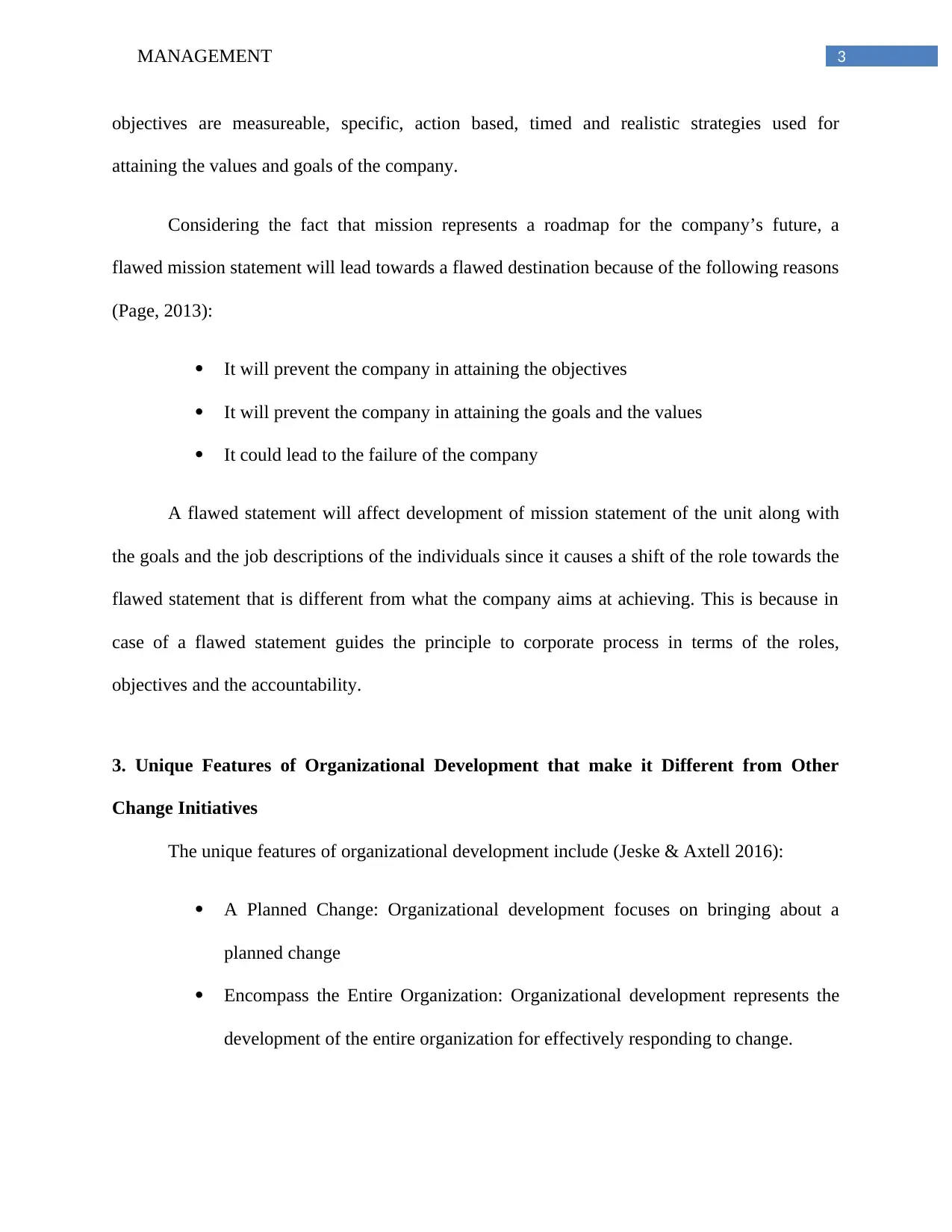
3MANAGEMENT
objectives are measureable, specific, action based, timed and realistic strategies used for
attaining the values and goals of the company.
Considering the fact that mission represents a roadmap for the company’s future, a
flawed mission statement will lead towards a flawed destination because of the following reasons
(Page, 2013):
It will prevent the company in attaining the objectives
It will prevent the company in attaining the goals and the values
It could lead to the failure of the company
A flawed statement will affect development of mission statement of the unit along with
the goals and the job descriptions of the individuals since it causes a shift of the role towards the
flawed statement that is different from what the company aims at achieving. This is because in
case of a flawed statement guides the principle to corporate process in terms of the roles,
objectives and the accountability.
3. Unique Features of Organizational Development that make it Different from Other
Change Initiatives
The unique features of organizational development include (Jeske & Axtell 2016):
A Planned Change: Organizational development focuses on bringing about a
planned change
Encompass the Entire Organization: Organizational development represents the
development of the entire organization for effectively responding to change.
objectives are measureable, specific, action based, timed and realistic strategies used for
attaining the values and goals of the company.
Considering the fact that mission represents a roadmap for the company’s future, a
flawed mission statement will lead towards a flawed destination because of the following reasons
(Page, 2013):
It will prevent the company in attaining the objectives
It will prevent the company in attaining the goals and the values
It could lead to the failure of the company
A flawed statement will affect development of mission statement of the unit along with
the goals and the job descriptions of the individuals since it causes a shift of the role towards the
flawed statement that is different from what the company aims at achieving. This is because in
case of a flawed statement guides the principle to corporate process in terms of the roles,
objectives and the accountability.
3. Unique Features of Organizational Development that make it Different from Other
Change Initiatives
The unique features of organizational development include (Jeske & Axtell 2016):
A Planned Change: Organizational development focuses on bringing about a
planned change
Encompass the Entire Organization: Organizational development represents the
development of the entire organization for effectively responding to change.
Paraphrase This Document
Need a fresh take? Get an instant paraphrase of this document with our AI Paraphraser
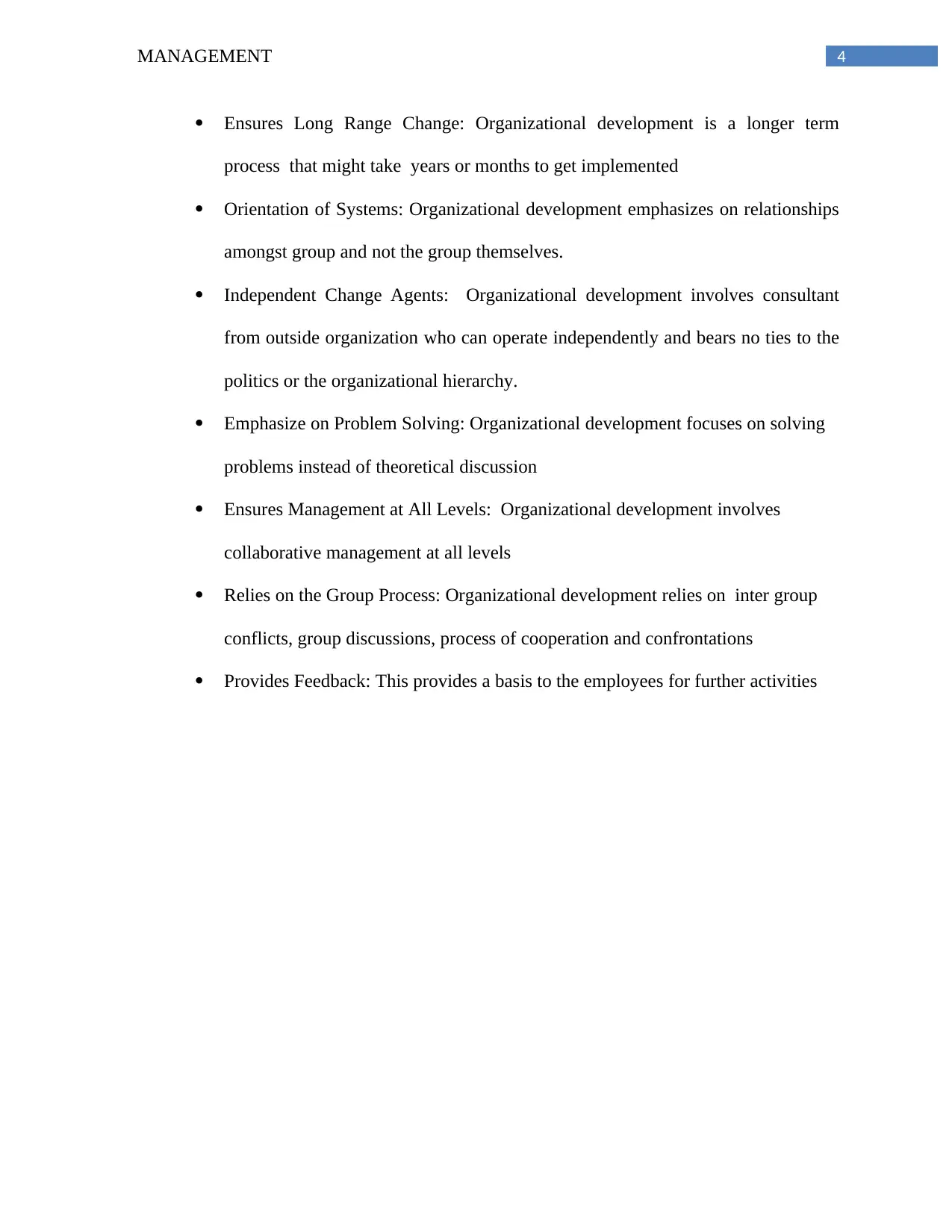
4MANAGEMENT
Ensures Long Range Change: Organizational development is a longer term
process that might take years or months to get implemented
Orientation of Systems: Organizational development emphasizes on relationships
amongst group and not the group themselves.
Independent Change Agents: Organizational development involves consultant
from outside organization who can operate independently and bears no ties to the
politics or the organizational hierarchy.
Emphasize on Problem Solving: Organizational development focuses on solving
problems instead of theoretical discussion
Ensures Management at All Levels: Organizational development involves
collaborative management at all levels
Relies on the Group Process: Organizational development relies on inter group
conflicts, group discussions, process of cooperation and confrontations
Provides Feedback: This provides a basis to the employees for further activities
Ensures Long Range Change: Organizational development is a longer term
process that might take years or months to get implemented
Orientation of Systems: Organizational development emphasizes on relationships
amongst group and not the group themselves.
Independent Change Agents: Organizational development involves consultant
from outside organization who can operate independently and bears no ties to the
politics or the organizational hierarchy.
Emphasize on Problem Solving: Organizational development focuses on solving
problems instead of theoretical discussion
Ensures Management at All Levels: Organizational development involves
collaborative management at all levels
Relies on the Group Process: Organizational development relies on inter group
conflicts, group discussions, process of cooperation and confrontations
Provides Feedback: This provides a basis to the employees for further activities
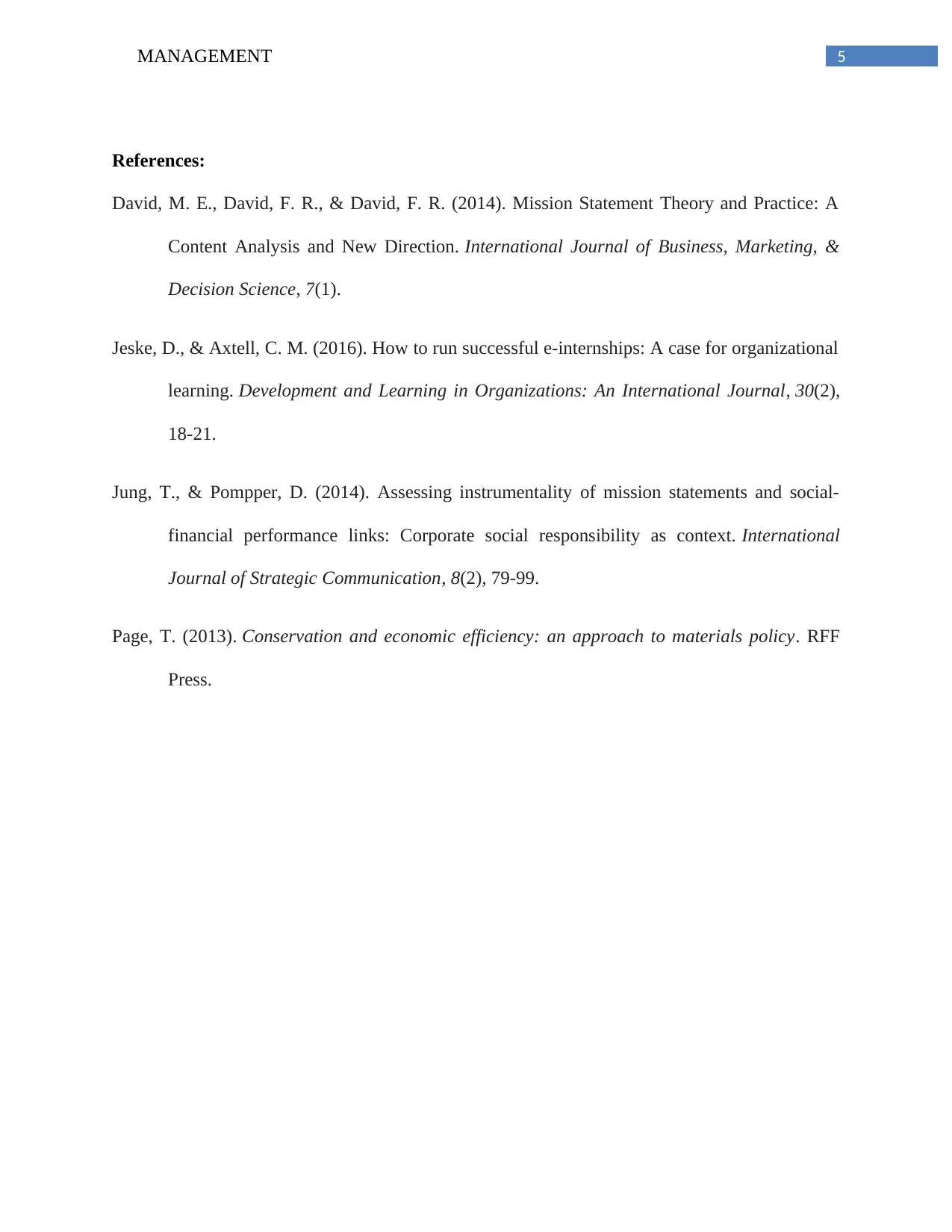
5MANAGEMENT
References:
David, M. E., David, F. R., & David, F. R. (2014). Mission Statement Theory and Practice: A
Content Analysis and New Direction. International Journal of Business, Marketing, &
Decision Science, 7(1).
Jeske, D., & Axtell, C. M. (2016). How to run successful e-internships: A case for organizational
learning. Development and Learning in Organizations: An International Journal, 30(2),
18-21.
Jung, T., & Pompper, D. (2014). Assessing instrumentality of mission statements and social-
financial performance links: Corporate social responsibility as context. International
Journal of Strategic Communication, 8(2), 79-99.
Page, T. (2013). Conservation and economic efficiency: an approach to materials policy. RFF
Press.
References:
David, M. E., David, F. R., & David, F. R. (2014). Mission Statement Theory and Practice: A
Content Analysis and New Direction. International Journal of Business, Marketing, &
Decision Science, 7(1).
Jeske, D., & Axtell, C. M. (2016). How to run successful e-internships: A case for organizational
learning. Development and Learning in Organizations: An International Journal, 30(2),
18-21.
Jung, T., & Pompper, D. (2014). Assessing instrumentality of mission statements and social-
financial performance links: Corporate social responsibility as context. International
Journal of Strategic Communication, 8(2), 79-99.
Page, T. (2013). Conservation and economic efficiency: an approach to materials policy. RFF
Press.
⊘ This is a preview!⊘
Do you want full access?
Subscribe today to unlock all pages.

Trusted by 1+ million students worldwide
1 out of 6
Related Documents
Your All-in-One AI-Powered Toolkit for Academic Success.
+13062052269
info@desklib.com
Available 24*7 on WhatsApp / Email
![[object Object]](/_next/static/media/star-bottom.7253800d.svg)
Unlock your academic potential
Copyright © 2020–2025 A2Z Services. All Rights Reserved. Developed and managed by ZUCOL.




